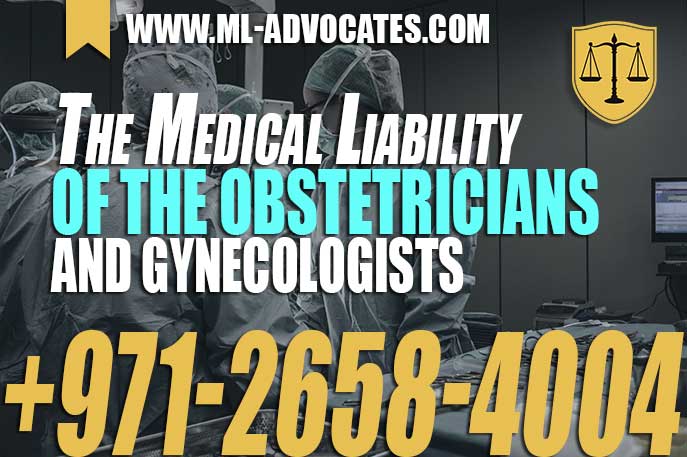
The Medical Liability of the Obstetricians and Gynecologists
The Medical Liability of the Obstetricians and Gynecologists The Medical Liability of the Obstetricians and Gynecologists
The Medical Liability of the Obstetricians and Gynecologists
In a recent ruling, Abu Dhabi Court affirmed that the doctor’s commitment is an obligation to give the technical care required by the principles of the profession, and that the base for this is the usual technical behavior of the average physician with knowledge, competence and vigilance, and that the doctor’s deviation from this behavior is an error in what the principles of the art of medicine have been settled upon, and it results in responsibility when the harm is related to this error, as the cause is related to the causer.
Whereas this, and the report of the Supreme Committee for Medical Responsibility concluded that (1-D. … on 26/6/2013) she did not examine the patient before the start of the cesarean section to ensure the progression of the head position in the pelvis with the possibility of vaginal delivery. Dr. … on 06/26/2013, after taking the child from the mother’s womb during the cesarean section, he did not check the position of the uterus, as an expansion of the uterine wound is expected and he did not complete the operation with Dr. … as she had difficulties in suturing the wound of the uterus, and perhaps expediting the operation might have helped to avoid the loss of other quantities of blood.
3- The severe bleeding that the patient suffered caused blood flow which made it difficult to control uterine bleeding.
4- On 7/13/2013, during the surgery that was performed, a decision was made to use temporary means to stop the bleeding and then transfer the patient to ….. hospital for the purpose of performing arterial coagulation. The decision was not appropriate because the patient had uterine arteries ligation in the first operation on 06/26/2013.
5- The best decision was hysterectomy, although it was difficult to perform it at the time.
6- From reading the file, it was revealed that the patient was transferred on 7/13/2013 to ….. hospital and she was in a critical condition where the pulse was very rapid and the vital signs were unstable with artificial respiration tube waiting for the arterial coagulation operation.
7- On 27/8/2013, before starting the surgery to clean and extract purulent inflammation from inside the uterus, where the damaged part of the anterior uterine wall was sutured, the best decision was to discuss with the patient the condition of the uterus before the operation and take approval to remove it as the operation was not an emergency and the patient was prepared for it well and there was time to discuss with the patient and her family, as the large number of operations increased complications as a result due to the attempts to reserve the uterus.
8- Although she has a rare blood type, blood transfusions and its derivatives were provided in a timely manner and the medical team was able to treat the case of severe uterine bleeding and saving the patient’s life was done well.
9- She was pregnant for the first time and because of pressure from her relatives to preserve the integrity of the uterus and avoid its removing, the treating team took several procedures and operations for fulfilling this purpose- preserving the uterus- despite the patient’s exposure to complications, some of which are uncommon). Whereas this, and the appealed ruling has surrounded the reality of the case and its evidence with insight and examined all aspects of deploring mentioned by the Appellant regarding the responsibility of its subordinates for the harm caused to the Appellee and the causal relationship and upheld the first instance judgment ruling with the responsibility of the Appellant and established its ruling on the findings of the report of the Supreme Committee for Medical Liability which, according to the Cabinet Resolution No. 31 of 2009, is a permanent technical committee specialized in expressing a technical opinion in the presence of the medical error or not, with an explanation of its cause, the damages resulting from it, if any, and the causal relationship between the error and the damage and any other matters required from it … based on the request of the competent court.
” After it was reassured to the integrity of its foundations and the adequacy of its research, and stated in its records that (since it was proven in the report of the Supreme Committee for Medical Liability that this court is reassured in this aspect that the Appellant came to ………….. hospital at 6:35 am, on 26/6/2013, she was suffering from childbirth pains, and that Dr. ………………….. did not examine the patient before starting the caesarean section at 13:25 in the afternoon, to ensure the progression of the head position in the pelvis with the possibility of vaginal delivery, especially that the patient had complete expansion of the cervix. On the other hand, Dr. ……………….., after extracting the child from the mother’s uterus, did not make sure of the position of the uterus, as an expansion of the uterine wound is expected and he did not complete the operation with Dr. …….. as she had difficulties in suturing the wound of the uterus. If he had completed the operation and sutured the wound quickly to avoid the loss of other quantities of blood, but he left before completing the operation, and this is considered a clear breach of the duties of the profession because he was called by Dr. ………….. who had difficulty extracting the fetus from the uterus and thus he had to complete the whole process, including suturing the wound, not to leave the place before completing the operation, and he did not return again despite being called again to suture the wound as he is the consultant obstetrician and gynecologist but he sent another specialist, Dr. ……………….. who is at the same level as Dr. …………………….. He was aware of this difficulty from the beginning. All of this led to the continuation of bleeding leading to fluidity, and this fluidity led to various operations to control uterine bleeding, to no avail, and the resulting attempt to treat the bleeding by various means before removing part of the uterus, and among these means opening the abdomen again and holding the uterine arteries from both sides and using connecting strings around the uterus, placing a balloon in the uterus and another in the vagina and giving the patient antibiotics while the bleeding continued and the doctors of ————– hospital tried on 07/14/2013 to control the same through injecting the uterine arteries with a coagulant material.
This operation resulted in pain in the right leg with the inability to move. On 08/24/2013, it was found that a part of the uterus was outside the wound and its emergence into the skin layer and the presence of a hernia in the wound, where on 27/8/3013 a part of it was removed in …………………… hospital and re-stitched. It is evident from the foregoing that the obstetrician did not perform an examination that would have spared the patient the trouble of a cesarean section.
It was decided to perform the operation and the uterine wound was not sutured quickly and efficiently. If it had been sutured this way, the uterus would not have bled leading to blood flow. This latter error led to the next series of procedures to stop the bleeding. Consequently, the hysterectomy … was in turn the result of a medical error, as well as other consequences, including pain in the right leg and inability to move. Therefore, there is no right to blame the Appellant or her family for trying to preserve the uterus to the maximum extent possible.
Mohamed Mahmoud Al Marzooqi law firm
Attorney / Mohamed Al Marzooqi
Mohamed Al Marzooqi advocates & Consultancy
Lawyer in Abu Dhabi, Dubai – UAE

“The Medical Liability of the Obstetricians and Gynecologists”
Tags:
- abu dhabi -
- Abu Dhabi UAE lawyers -
- Arab united emirates -
- Aspects of Medical Malpractice -
- attorney in dubai -
- attorney injury -
- attorneys specializing in medical malpractice -
- Doctor -
- Doctors -
- find a medical malpractice lawyer -
- hospital attorneys -
- hospital malpractice attorneys -
- hospital malpractice cases -
- hospital neglect attorneys -
- hospital neglect lawyer -
- hospital negligence -
- hospital negligence attorneys -
- law firms in abu dhabi -
- law firms in sharjah -
- lawyer for hospital -
- lawyer for hospital negligence -
- lawyers specializing in medical malpractice -
- lawyers that handle medical malpractice -
- legal medical malpractice -
- legal medical malpractice lawsuit cases -
- Legal proceeding -
- local medical malpractice lawyers -
- Medical -
- Medical Malpractice -
- medical malpractice and personal injury -
- medical malpractice attorney -
- medical malpractice case -
- Medical Malpractice Cases -
- medical malpractice claims -
- medical malpractice court cases -
- medical malpractice law -
- Medical Malpractice Lawsuit -
- medical malpractice lawyer -
- negligence cases in hospitals -
- physician malpractice and negligence -
- physician’s treatment -
- Plastic Surgeon -
- recent medical malpractice cases -
- Reporting Adverse Medical Occurrences -
- UAE











